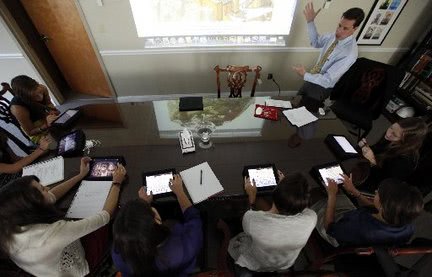The mobile computing market changed forever a few years ago with the introduction of the netbook. Finally a small, reasonably lightweight personal computer that could be carried by anybody. Then the technology companies brought us a new breed of powerful ultraportables and finally tablets. One thing to note though is that prices haven’t changed much, if at all, in the last few years. Now you could say that this is probably down to the global economic downturn, problems facing technology manufacturing after the Japanese earthquake or one of a great many factors. The fact remains though that around the computing market the prices of other devices such as high-definition televisions and digital cameras have continued to fall.
Now I’m a teacher by my first trade, and a tech author second. I’ve been spending the last few years teaching Literacy and Numeracy to the long-term unemployed who need better skills and qualifications in order to be able to get back into the workplace, or to those people who are already employed and need qualifications to progress their careers. I’m very interested then in the use of technology as an educational aid and, if you’re interested, you can read an essay I wrote on the subject for my teaching qualification here where I talked about some of the issues and barriers for the use of technology in the classroom, including the legal, physical and mental barriers that some people need to overcome.
 It’s always with great interest then that I read news stories about how the latest technology is being used in classrooms. In the last year I’ve seen schools, mostly in the US, giving iPads to each student and writing custom apps for the platform to help improve learning in class; one particularly interesting app was using the tablet’s accelerometer with a special app that helped the students simulate earthquakes. I’ve also seen the use of videoconferencing to enable schools to share teachers with specific expertise and to bring in experts from the worlds of business, science and society.
It’s always with great interest then that I read news stories about how the latest technology is being used in classrooms. In the last year I’ve seen schools, mostly in the US, giving iPads to each student and writing custom apps for the platform to help improve learning in class; one particularly interesting app was using the tablet’s accelerometer with a special app that helped the students simulate earthquakes. I’ve also seen the use of videoconferencing to enable schools to share teachers with specific expertise and to bring in experts from the worlds of business, science and society.Why is it then, six years after the launch of the One Laptop Per Child (OLPC) project that intended to create laptops for developing countries for only $99 that we don’t have schools rolling out laptops, netbooks or tablets to their students every year? From the perspective of the technology companies this is an enormous market and opportunity; indeed Bloomberg arereporting today that Apple are bidding to sell 15 million iPads to schools in Turkey.
The single biggest barrier however is still price. In order to make mobile devices that will appeal to the consumer and trample upon the competition, companies are still going for quality, brushed metals, high quality plastics and IPS panel screens. What they’re not focusing on is the schools and colleges mass market where what’s required is ruggedness and affordability; after all these machines will be designed to only be used in educational establishments for their purposes.
Next week does see the launch of a new affordable Android tablet, the affectionately named (for anyone of a certain age in the UK anyway) AndyPad. Starting at just £129 this is finally approaching the price levels that technology needs to be at to appeal to the huge volumes and limited budgets of schools worldwide, and of course some of the money can be saved elsewhere in providing cheaper eBooks instead of the traditional paper copies (while being more environmentally friendly into the bargain).
The fact remains though that back in 2005 when Nicholas Negroponte announced his plans to create a $99 educational laptop for the developing world the whole world got very excited. Then companies like Microsoft decided that they wanted a piece of the action, muscled in and muddied the whole situation. Now we don’t have any $99 laptops and there’s no immediate prospect that this will change.
It’s worth noting that some smaller companies have tried to release $99 tablets, certainly here in the UK, and all have so far been rubbish. What must be needed then is the technological know-how and the manufacturing clout of a big name player. Could Apple make a $99 iPad? The company certainly makes enough money to subsidise such a device and it would sell in enormous volumes. How economical that would be to a company with shareholders to pay though is up to Apple’s board to decide.
So I find it a pity that in what might turn out to be the ‘golden age’ of mobile computing that children are still being left out, especially the millions of them on low household incomes who still don’t have a computer at home. It’s time I think for the technology companies to step up to this challenge and prove that $99 can still be achieved for the benefit of everyone.
No comments:
Post a Comment